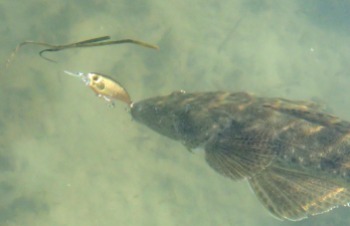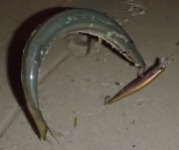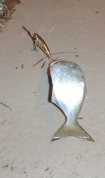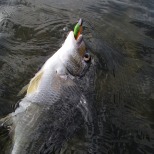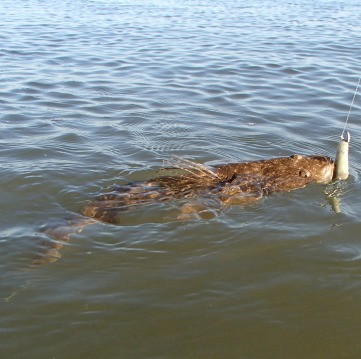Sunday
I could fish for a few hours early on Sunday. So I drove up to Bribie. The tide was not ideal. It would be a 2.1 m high at about 6.30 am – which is just about sunrise, at this time of year. I arrived just after first light, at about 6.10 am and waded out under the bridge. There was no wind and conditions were perfect for boating. There were a few boats out already, collecting live bait under the bridge lights.
I heard a few big splashes and could just make out a dolphin putting on its best ‘Seaworld’ display, out in the middle of the Passage. Miraculously, I caught its silhouette, clear of the water, in a photograph, but there was not enough light to make it a good shot. The boats anchored close to the bridge would have had a fantastic view of the show.
I headed for my usual fishing zone – to the south of the old oyster jetty. But as the tide was in, I would be fishing the shallows, close to the foot of the mangrove roots, rather than the edge of the weed beds, further out.
I started with a GULP Jerkshad soft plastic in the Peppered Prawn colour. Someone asked me what has happened to my favourite – Watermelon Pearl colour. My problem is that I cannot seem to find them anywhere, at the moment. It is still my favourite colour, but a lack of stock in Queensland is forcing me to try different things. So Berkley Australia – http://berkley-fishing.com.au/company/berkley-australia/ – if you are reading, time to re-stock the retailers with the Watermelon Pearl 4” Minnow soft plastic!
The Peppered Prawn Jerkshad did not let me down, however. I was slowly hopping it along the bottom, in less than a meter of water, when I felt a fish grab it. It was a 45cm flathead. I released this one and moved on. About 10 minutes later, I had reached the gap in the mangroves, just before the shoreline turns west, towards Sandstone Point. There is a drain in front of this spot and a few deeper hollows in the sand. I cast towards these and soon found another flathead – a good size this time – just under 60 cm.
Things went quiet as the tidal run slackened, so I swapped to a small hard bodied lure – the DUO Realis Shad 59 MR. I fished this around the same area and had a couple of grabs and knocks – which could have been bream or the long toms. At about 8.00 am I caught another 45 cm flathead on this lure.
Then things went quiet. I fished for another 2 hours without a touch. It was a perfect day and so there was a constant flow of boats heading out into the bay, which may have slowed the fishing down a little. Beautiful morning but once again, fishing the high tide had been hard.









